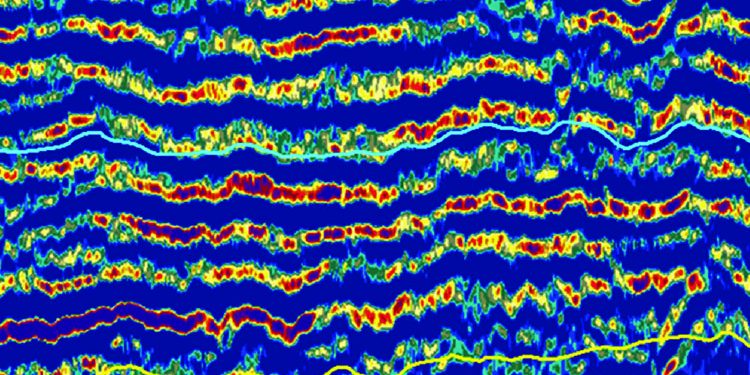Exploring the Resource Potential of the Pre-Jurassic Sedimentary Complex in the West Siberia
(Part 1 – Geology of the Pre-Jurassic Complex)
Geology of the Pre-Jurassic Complex
The Global Abundance of the Fields Associated with Platform Basement Rocks
As the level of knowledge about deposits in the Jurassic-Cretaceous depositary complex in the Northwestern Siberia grows, while the addition of reserves declines, geologists turn more of their attention to the exploration of potential oil and gas bearing capacity in the Pre-Jurassic sedimentary complex. Various publications provide a wide range of examples of commercial petroleum bearing capacity of non-conventional targets in fractured granitoid and carbonate reservoirs of the basement rocks of platform regions. [1,2,6,7,8].
In total, an estimated 500 hydrocarbon fields have been discovered in the basement rocks to date. The first commercial inflow of oil and gas from the fractured granites were obtained in the Panhandle-Hugoton field (USA) in 1918. Later on, more deposits were discovered in Venezuela, where oil occurrences were found in uncompacted metamorphic rocks and granites of the La Paz oil field, in Canada (Peace River), in Libya (Nafoora-Augila), in Egypt (Ramadan) and some other places. More intense interest to the prospects of basement rocks was aroused after the White Tiger oil field was discovered offshore of Vietnam in 1988, whose deposits were associated with granites of the Mesozoic basement.
The phenomenon of the natural reserves being replaced at developed fields, due to the inflow of “fresh oil” from tectonic faults of the crystalline basement, has become an important factor of additional interest to the prospect of basement rocks. This effect was recorded in the ‘90s of the past century in the depleted fields of the Chechnya that had been developed for over 50 years. The effect of the flow rates recovered in completely water-cut and long-term idle wells was noticed here. At first, this was explained either with underestimation of recoverable reserves, or with migration of residual oil, caused by the action of gravity. However, by early 2000s, this phenomenon of the hydrocarbon (HC) reserves replaced in operated deposits was largely noticed at all of the “old” petroleum provinces (the Volga-Ural petroleum province, the North Caucasus petroleum province, etc), where fields were operated from the 1940s-1950s onwards, and some even earlier. The modern research established the facts that oil fields, as a rule there exist oil-conducting channels under oil fields, due to which the latter were formed. In the course of field development, these channels may become active and replenish those traps with new portions of hydrocarbon fluids. It was proved (R.Muslimov and others, 2018) [5,9] that the essential role in the permanent “feeding” of sedimentary cover oil fields is played with the crystalline basement which provides the transition of HC from the subsurface along its transcurrent faults into any sort of traps. It was noted that the feeding processes are typical for, first of all, major developed fields, and super giant fields may count tens of such feeding zones. The significance of such processes is considerably lower at small and medium-size fields [9].
The materials of drilling the superdeep Tyumenskaya SG-6 and Yen-Yakhinskaya SG-7 wells made it possible to more optimistically reason the possibility of oil generation in Paleozoic formations. The examination of core samples, selected from the Paleozoic deposits, revealed the presence of oil-and-gas source rocks which were referred by researchers to be highly productive oil-and-gas thicknesses. The conducted research revealed an intensive migration of hydrocarbon fluids across the entire area of a well column, including the effusive complex of Paleozoic rocks [11].
Taking into account all of the above-mentioned facts, it becomes evident that, with the availability of traps in the fractured or other type reservoirs, they would first of all be filled with hydrocarbons by way of their migration along the crystalline basement transcurrent faults, and by lateral migration from the adjacent sedimentary sheath rocks.

To illustrate the above said, we present a geologic cross-section of the White Tiger field here (Fig.1), as well as the spread of the basement rocks with various properties (Fig.2).

Thus, significantly major commercial deposits of oil and gas in the magmatic and metamorphic basement rocks have been largely discovered in all of the continents and in the offshore areas of the World Ocean, and they are associated with deep-seated faults providing, as multiple geological field data shows, the vertical HC migration.
However, in spite of the discovery of significantly major fields, the searches for the basement HC deposits have been conducted in limited scopes. It is conditioned by the geological complexity and insufficient level of knowledge of the target. For instance, the nature of sorptive capacity of the basement rocks and their permeability is not yet completely clear, there is as of yet no available methodology of determining a reservoir quality, and there are many problems related to substantiation of technology for their optimal development.
Over the last years, more researchers have been giving up the concept of full negation of the potential oil and gas bearing capacity of basement rocks due to high degree of transformations taking place in the crystalline, magmatic and metamorphic rock. As E.Yu.Khalimov notes [1], the modern lithosphere plate tectonics concept, the subsurface rock deformation dynamics make it possible to consider the basement rocks as non-conventional type of container rocks which may promise a great hydrocarbon potential.
Distribution of the HC Deposits in the Pre-Jurassic Complex of Rocks in West Siberia
Let’s consider the prospects of the Pre-Jurassic complex of the West Siberian Basin, including, aside from the Paleozoic formation, the Triassic rocks and the crust of weathering, which, to our mind, represent a unified hydrodynamic system.
For that time as geologic surveys were conducted in the West Siberia (within the boundaries of the Urals Federal District), over 90 deposits of more than 30 fields have been discovered in the Pre-Jurassic complex, with oil in-place reserves amounting to 200 MMT, with the cumulative production making up to 15 MMT.
The productive and perspective traps discovered in the scope of the Pre-Jurassic complex of the West Siberia are divided into three types of targets. The first type includes the local elevations in the area of sedimentary deposits developing in the Triassic layer; some researchers interpret them as the basal levels of the Lower Jurassic period. The second type includes the structural and stratigraphic traps in the areas where Triassic thicknesses feather onto the basement highs. The third type is featured with traps located in the erosion and tectonic highs of the basement (the crust of weathering). This one is most perspective for discovery of commercial accumulations of hydrocarbon raw materials, as it is associated with the elevated blocks of basement, with the traps having hydrodynamic association with the horizons of Triassic and Lower Jurassic complexes.
The study of the issue of the deposits formed in the disintegrated rocks of the pre-Mesozoic basement is an actual task for today, as the deposits of this kind are, in essence, the only reserve for localization of large volumes of reserves in the areas with a high degree of geological exploration.
The HC deposits of the Pre-Jurassic complex of rocks have been largely discovered across the whole area of the West Siberian province (Fig.3).

For instance, gas deposits were discovered in Berezovsky district, which were formed in the area of the adnation of carbonate-rich sandstones of the Upper Jurassic Vogulkin Suite to the disintegrated rocks of granites and granite-gneisses.
In the Shaimsky district, in the zones of the adnation of the Vogulkin Suite to disintegrated metamorphic and intrusive rocks, oil deposits were formed.
Commercial oil reserves were discovered in the territory of Tomsk region, in the disintegrated carbonate rocks of the Middle Paleozoic period, in the areas of adnation of the Lower Jurassic oil bearing deposits, including major fields (Kalinovoye, Archinskoye, Urmanskoye, Rechnoye, Ostankinskoye, Severo-Ostankinskoye and some others). An oil deposit was also discovered in serpentized ultrabasites in the Festivalnaya area.
Oil deposits were discovered in the Ob River region, in the zone of disintegrated carbonate rocks of the Severo-Varyeganskaya area, and in the bleached zone with effusive rocks of the Triassic period, in the Rogozhnikovskaya area.
A major gas condensate field was discovered in the Yamal Peninsula, in the bleached zone of carbonate rocks of the Novoportovskaya area.
Exploration of the weathering crust (the disintegration zones), involving many types of rocks, revealed that the chemical and physical processes have been the major factors in determining their formation. They result in the formation of cavities, fractures, porous space, i.e. the processes of the primary rock structure destruction and bleaching both take place there.
The rocks of the Pre-Mesozoic basement underwent the durative processes of hypergenesis. To a considerable extent, hypogene tectonic processes took effect on the formation of this type of reservoir, which lead to both the compression of porous space and its expansion. As for the various rocks of the Pre-Mesozoic basement, the formation of a porous and fractured reservoir by intrusive and effusive felsic rocks is observed, according to core sampling, which is predetermined by desalination of feldspars and some other minerals.
As for carbonate rocks, intensive karstification and cavern development takes place there, as well as the filling of sinkholes with cherty breccias. As for amygdaloidal volcanic rocks (basalts), processes of both their hydrothermal replacement with carbonate materials, and desalination of amygdales are observed there, which results in the creation of a framework porous reservoir [1].
The analysis of the geologic structure of the discovered deposits makes it possible to draw the following conclusions: the deposits are formed in the erosion of tectonic highs; disintegrated rocks of the pre-Mesozoic basement serve as a reservoir; the type of deposits is stratigraphic; the deposits are screened with the thicknesses of argillites and aleurolites of Jurassic age which rest with angular and stratigraphic unconformity on reservoir rocks of the erosion tectonic highs; the deposits in the erosion tectonic highs are formed in the area of adnation of the potentially hydrocarbon-bearing Jurassic deposits; the discovered accumulations of hydrocarbons in the erosion tectonic highs are located within the outreach of the potentially oil-and-gas-bearing Jurassic deposits.
We should note that most of the deposits were discovered in the weathering crust in the of the top part of the basement. This part of the section has been explored more than others, since the prospecting wells, as a rule penetrate a basement for the first scores of meters, and then testing goes on within that single interval, in case the direct signs of oil bearing capacity exist there. The underlaying rocks were not largely explored by drilling, and one could talk about their properties only after their seismic survey data or the results of other geophysical techniques are obtained.
The Criteria of Prospecting Oil and Gas Deposits in Basement Rocks
Based on the analysis of the geological settings of the basement deposits of oil discovered worldwide, including the sedimentation basins of Vietnam, the following criteria for prospecting oil bearing capacity have been singled out [7]:
• development of rift zones in a basement;
• basement block structure;
• presence of faults and the basement rock decompression zones, associated with them;
• presence of regional fluid seal rocks capping the basement rocks;
• presence of deposits in sedimentary sheath, as a sign of general oil and gas bearing capacity of the area;
• neotectonic activity of the basin area.
It is obvious that exactly due to the presence of the above mentioned signs , the traps, detected according to the seismic survey data, shall be most likely capable of oil and gas bearing there.
Potential Petroleum Bearing Traps in the Pre-Jurassic Complex of the North-Western Siberia, According to Seismic Survey Data
Hereafter, examples are given with potential petroleum bearing traps of various types, delineated in the Pre-Jurassic rock complexes in the various areas of the South-Eastern part of the Pur-Tazovsky petroleum bearing region.
50 meters of pre-Jurassic deposits were tapped in the well Yutyrmalskaya # 15; they are represented with dislocated (angle of rock sheets varies from 60º to 90º) terrigenous-carbonate rocks of the Missisippian period with interlayers of igneous mafic rocks. Corbanaceous pitch can be found in oranogenic limestones.
Subporphyritic basalts were tapped in the Severo-Tolkinskaya well # 304 which have been conventionally dated with the Vendian-Early Paleozoic period /Bochkarev, 1995/. A potential petroleum bearing target was delineated, according to mud logs, in the interval of 3795 to 3818m, in the weathering crust.
According to the interim seismic cross-sections, the pre-Jurassic seismic complex (ССК1) of the top is confined with reflection horizon “A”, featured with abruptly changing dynamic expressiveness across the area, and namely, more vivid traces of it are in the relatively plunging relief, and less vivid in the elevated areas where the reflection wave “A” also involves some discontinuity of the wave patterns and their interference (Fig.4). Inside this complex, bowls stand out within the plunged areas, which, according to the seismic recording configuration, are apparently filled with stratified terrigenous deposits of the Triassic age. The deposits, with which the bowls are filled are featured in the seismic cross-sections with dynamically expressed continuous subhorizontal reflections. From the perspective of the potential petroleum bearing capacity of the pre-Jurassic complex, the erosion tectonic highs of disintegrated pre-Jurassic rocks may be of prospecting interest, as well as the areas where the Triassic deposits pinch out towards the basement surface, which are considered to be possible lithologically screened leads (Fig.5,6).

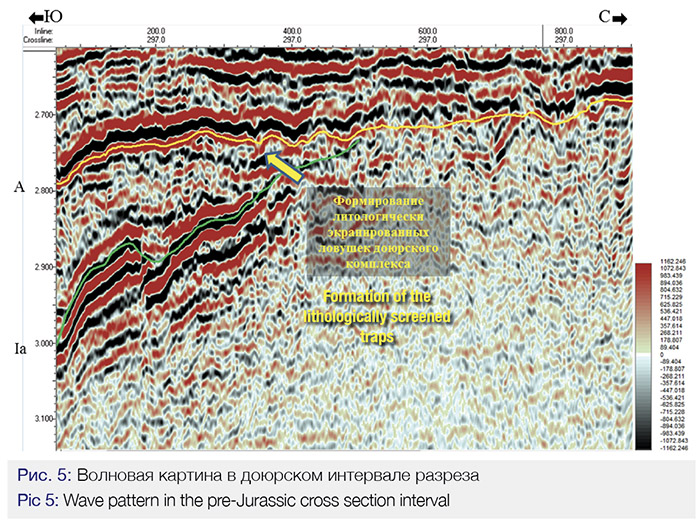
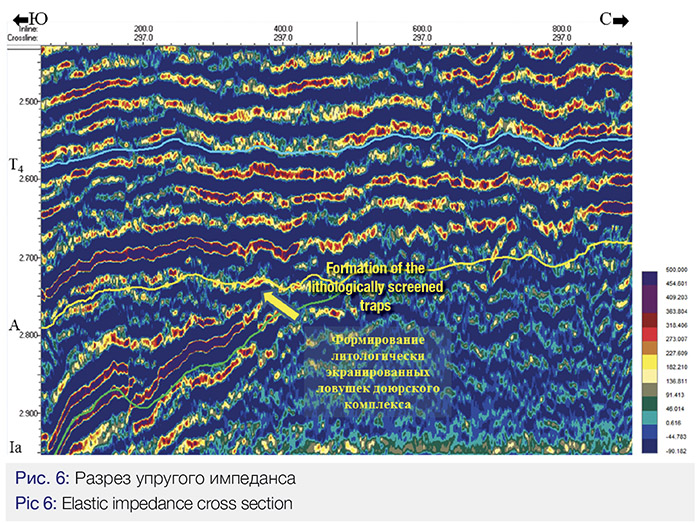
Considerable prospecting interest, as said above, is attracted to the areas of the disintegrated Jurassic rocks in the basement highs, which may form large-volume stratigraphic traps. To delineate and localize them, dynamic seismic attribute analysis has been applied.
The deposits of the pre-Jurassic complex were poorly explored by drilling in the considered area; therefore its potential petroleum bearing capacity can be evaluated on a qualitative level only. The presumed potential distribution area of rocks was conventionally delineated with the use of joint analysis of the dynamic seismic attribute maps and the visual analysis of the interim seismic cross-sections, which are associated with the areas of disintegrated Paleozoic deposits, presumably featured with reservoir properties.
The interim seismic cross-sections illustrate that the weathering crusts correspond to the areas of interference and lower traceability of the reflecting horizon A, while the map of RMS amplitudes shows their correlation with the low values of RMS amplitudes along the reflecting horizon A (calculation window 0/+50 ms) (Fig.7) The above mentioned potential petroleum bearing areas are also associated with the areas of low values of the seismic attribute in the derived RMS maps of the seismic signal energy, calculated along the reflection horizon “A”, in the window of 0/50 ms, by the amplitude volumes.
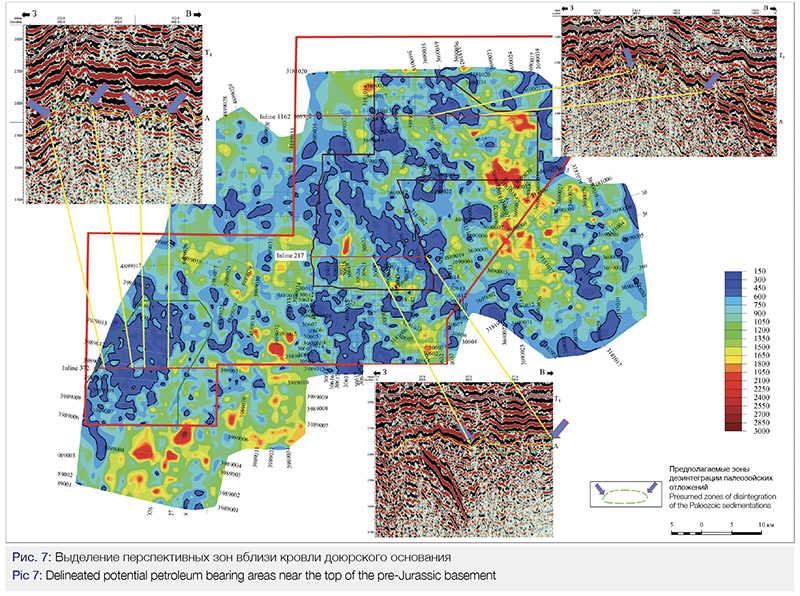
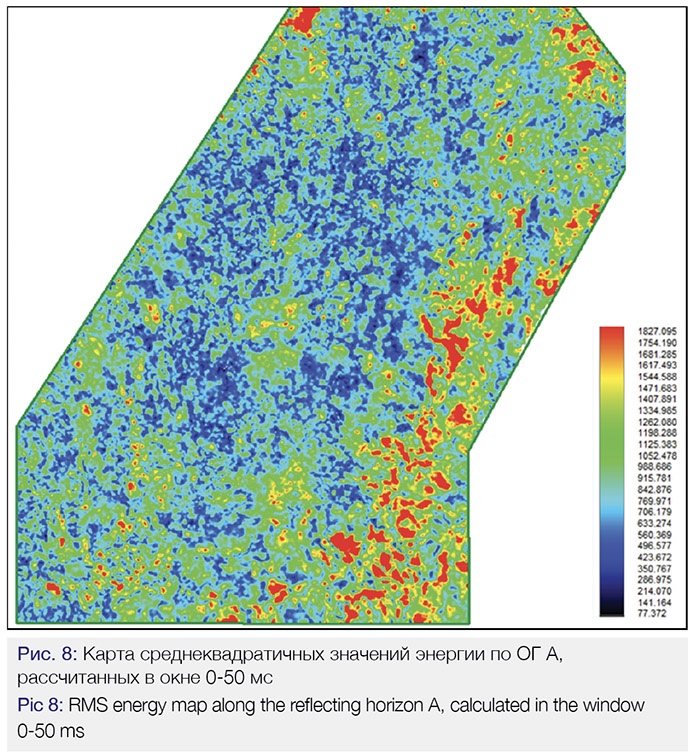
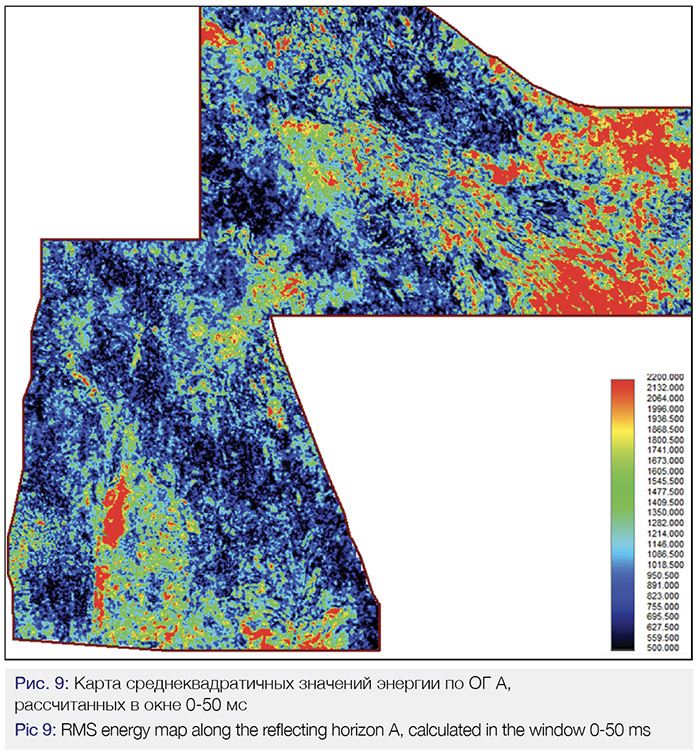
To estimate the potential petroleum bearing capacity of the pre-Jurassic complex, maps of dynamic seismic attributes were designed in a wide range of windows under the reflection horizon “A”.
As a result of the integral analysis of the wave pattern in the interim seismic cross-sections and the seismic attribute map, the distribution areas of the Triassic deposits, filling the ancient bowls of the Paleozoic basement, supposedly of the Tampeian series, was sketchily mapped (Fig.10).

The delineated targets have a sufficiently large size and have the form of high-capacity potential petroleum bearing traps.
Specifics of the Assessment of the HC Reserves in Basement Rocks
Calculation of the HC reserves and resources in the West Siberian deep-seated rocks of pre-Jurassic age is significantly hampered due to their insufficient exploration maturity and the difficulty in interpretation of the obtained data. Geologists have no consensus on the issue of delineation of acting reservoirs in the effusive terrigenous, magmatic and metamorphic rocks, considerably reworked in the course of their plunging. The issue of geological structure and the hydrocarbon trapping mechanism for bonded deposits of monolithic thicknesses is still under discussion. Herein above we showed the possibility of delineating traps of HC deposits based on the interpreted seismic survey data. Nevertheless, to estimate the reserves, one should know the distribution of reservoirs within a trap, the location of the boundaries in the areas where they are completely absent. Higher tectonic activity at great depths determines considerable changeability of the structure and properties of the reservoir and fluid seal rocks. Pre-Jurassic complex is characterized by rock density and increases with depth, while the permeability decreases, and the nature of cavitation is changing – from a porous type it turns into a pore-fractured, fissured-cavernous cavitation [11].
Calculation of HC reserves in the pre-Jurassic complex is considerably hindered by a significant separation of reservoir beds. As a rule, they are divided into fragments by faults, areas with no reservoirs, etc., which is reflected in discontinuous wave pattern in the seismic cross-sections. The extreme heterogeneity of productive strata structure is noted in the bulk of the discovered deposits, in particular, a chaotic distribution of reservoir rocks and dense impermeable rocks, as in the case of the White Tiger field (Fig.2).
Thus, due to insufficient degree of knowledge, the nature of the sorptive capacity and the permeability of the basement rocks is not known to date, no reservoir quality discrimination methods based on logging data have been developed yet, there is no petrophysical basis for assessment of the reserves. In these conditions, to our way of thinking, the model of a “composite reservoir” appears to be the most adequate model, based on which the calculation of reserves can be carried out in the deposits of the Bazhenov and Abalak Suites. Using this approach, the part of strata is considered to be productive, within which the zones of jointing having secondary capacity and permeability were established, from which oil inflows were obtained. These parts of the cross section, delineated according to hydrodynamic logging data, are conductors of oil into a well, and they drain the matrix feeding it with oil. In the absence of permeable interlayers in cross section, the rocks, composing it, are referred to as non-productive, not yielding oil rocks. Oil reserves are not counted in such parts of cross-section.
When calculating oil reserves in basement rocks and predicting oil production, one should take into account that the initial oil in place reserves may vary. It was shown in the works by Kazan’s professor R.Kh.Muslimov [9] that the factual material accumulated for all the years while fields were being developed in the “old” oil producing regions unambiguously confirms that oil reserves, as the process of development goes on, may not only decrease but increase as well, due to continuous “feeding” from the crystalline basement through tectonic fissures and faults.
Summing up the above, one can state that the degree of knowledge regarding the deep-seated pre-Jurassic sedimentary and crystalline formations grows, more and more facts arise indicative of their high potential oil and gas bearing capacity. The modern seismic survey methods provide opportunity to delineate, in this rock complex, traps of considerable size, potentially bearing oil and gas in commercial volumes. To our mind, there exist all of the preconditions for a more extensive prospect-evaluation survey, which must confirm the prediction made by academician A.A.Trofimuk that the Paleozoic oil in the West Siberia would become a “golden tray” for its Mesozoic resources.
CONCLUSIONS ON GEOLOGY
1. HC fields, including major ones, were discovered in the magmatic, metamorphic and carbonate basement rocks in practically all of the continents of the Earth, and in the offshore area of the World Ocean.
2. Facts of oil fields being “fed” through the crystalline basement’s transcurrent faults have been established in practically all of the “old” petroleum provinces. As hydrocarbons vertically migrate, they are most likely to fill those basement traps that are confined in the areas of disruption of rocks composing that basement.
3. The latest achievements of in the area of geological science and multiple facts of the commercial potential oil bearing capacity in the basements in all of the petroleum bearing provinces in the world let a growing number of researchers to consider the basement rocks as non-conventional type of reservoirs possibly associated with a great potential hydrocarbon bearing capacity.
4. Oil deposits in the pre-Mesozoic basement of the West Siberia are associated with disrupted metamorphic, intrusive and carbonate rocks, the deposits are of stratigraphic type.
5. Based on the analysis of the geological conditions of oil deposited in the basement, tectonic and lithological features were revealed, whose presence speak for high probability of the potential oil bearing capacity of the traps, discovered in the pre-Jurassic complex.
6. The seismic data interpretation methods described in this article make it possible to confidently map the leads of various types in the pre-Jurassic complex of rocks.
7. Due to the insufficient exploration of the filtration-volumetric characteristics of basement rocks, the absence of methods for delineating reservoirs according to well logging data and petrophysical basis, the calculation of reserves is advisable to be carried out with the use of a “composite reservoir”, according to which separate assessments are performed for the reserves contained in the oil conducting channels and in the dense rock matrix drained by them.
REFERENCES
1. Yu.E.Khalimov. Petroleum Potential of Granitoid Basement Reservoirs. “Negtegazovaya Geologiya” (Petroleum Geology). Theory and Practice. #4, 2012.
2. V.P.Gavrilov, V.L.Gulev, F.A.Kireyev Granitoid Reservoirs and Petroleum Potential of the Southern Vietnam Shelf. – Moscow, Nedra Publishing House, 2010 – 294 pp.
3. K.B.Ashirov., T.M.Borgest, A.L.Karev.
Rationale for recurrent sustainability of oil and gas deposits at the fields developed in Samara region. Bulletin of Samara Research Center under the Russian Academy of Sciences, vol.2 #1, Geology, geophysics and geochemistry, 2000.
4. V.A.Trofimov Comprehensive Solution of the Enhanced Oil Recovery Issue from the «Old» Fields – Oil Production Directly from the Oil-Bearing Channels. Georesursy (Georesources) #4(54). 2013, pp.65-68.с. 65-68.
5. R.Kh.Muslimov, I.N.Plotnikova Consideration of the processes of oil deposit reformation during long-term operation and deep feeding in modeling the development of oil fields. Materials of a conference “Georesursy” (Georesourses), 2018. 3. pp.186-192.
6. E.Yu.Goryunov, R.A.Mamedov, M.H.Nguen, S.A.Mamedova. Criteria for Prospecting Petroleum Bearing Potential of Basement in West Siberia. Oil and Gas Exposition. #5 (72), 10.2019.
7. E.Yu.Goryunov, M.H.Nguyen THE MAIN FEATURES AND REGULARITIES OF THE OIL AND GAS FIELDS STRUCTURE IN THE BASEMENT OF СUU LONG BASIN (VIETNAM) // Oil and Gas Exposition. 2018. #4 p.18-22. .
8. M.H.Nguen, E.Yu.Goryunov, V.A.Trofimov. Basic Indications of Potential Petroleum Bearing Capacity of the South Vietnem Offshore Basement // “Nefyanaya Provintsiya”(Petroleum Province).2017.#3 pp.29-47.
9. R.Kh.Muslimov Deeper Study of the Crystalline Basement of Sedimentary Basins –The Imperative of Time. Georesursy (Georesources).#21(4) pp.55-62, 2019.
10. V.S.Surkov, G.M.Trigubovich and others. “To developem a geologic model of the Pre-Mesozoic Basement of the West Siberian Plate on the Basis of Complex Interpretation of Drilling Materials, Seismic Survey Data and Potential Fields», FGUP “SNIIGGIMS”, Novosibirsk, 2006.
11. S.A.Punanova, V.L.Shuster. The New Look at the Potential Petroleum Bearing Capacities of Deep-Seated Pre-Jurassic Deposits in the West Siberia. Georesursy (Georesources), vol.20 #2, pp.67-80, 2018.
Authors:
Evgeny Popov – Executive Director (Nedra-Consult LLC)
Yuri Stovbun – Deputy Chief Geologist (Nedra-Consult LLC)
Anastasia Russkih – Head of the Hydrodynamic Modeling Department (Nedra-Consult LLC)

